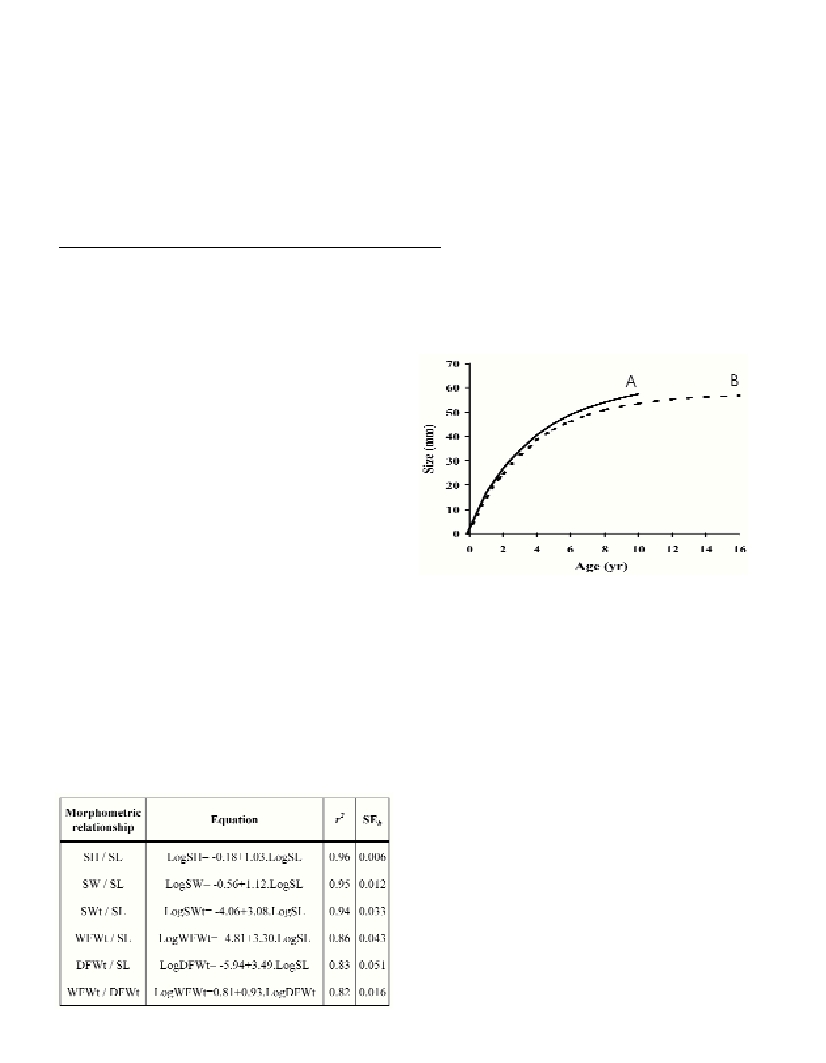PRELIMINARY OBSERVATIONS ON THE RELATIVE AND ABSOLUTE GROWTH
OF THE SMOOTH CLAM, CALLISTA CHIONE(L, 1758) (BIVALVIA: VENERIDAE)
FROM THE THRACIAN SEA, NE MEDITERRANEAN
P.K. Leontarakis
1 *
and C.A. Richardson
2
1
Fisheries Research Institute, N.AG.RE.F., Nea Peramos, Kavala, Greece - * fri@otenet.gr
2
School of Ocean Sciences, University of Wales, Bangor, Menai Bridge, LL59 5AB, Anglesey, U.K - c.a.richardson@bangor.ac.uk
Abstract
The relative and absolute growth of the smooth clam, Callista chione(L, 1758) from the Thracian Sea was determined at two sites. The
relationships amongst several size variables of the ?esh and shell showed clearly that growth was allometric. Age determination was
carried out from rings on the external shell surface and acetate peel replicas of shell sections. Von Bertalanffy growth parameters were
estimated. C. chioneis a slow-growing bivalve, attaining a size of 70-75 mm and an age of 11 to 16 yr.
Keywords: Callista chione; Bivalvia; Allometric relationships; Age; Growth
Rapp. Comm. int. Mer Médit., 37,2004
387
Introduction
The smooth clam, Callista chione(L, 1758), is a shallow-
burrowing filter feeder, inhabiting sandy sediments mainly in Medi-
terranean Sea, from just offshore to a depth of about 130 m [1].
Despite its economical importance, available information on its
biology and ecology is limited. The present work is the first attempt
to study various aspects (e.g. relationships between several shell and
?esh size variables, age, growth) of its biology in the Thracian Sea.
Materials and methods
During December 2001 to June 2002, smooth clams were collected
from two sites off Thassos Island, at depths between 1 and 3 m at a
0.5 m interval, using a metal box quadrat (100X100X10 cm). Shell
length, height, width (as defined in [2]; to the nearest 0.1 mm), shell
weight, wet ?esh weight and dry ?esh weight (to the nearest 0.0001g)
were measured in the pooled sample (shell length: 16-72mm). Linear
regressions were fitted to the log
10
-transformed data, while
t-test [2] was used to identify allometry. Rings on the external shell
surface and characteristic microgrowth patters apparent on acetate
peel replicas of shell sections [3], were used for age determination.
The von Bertalanffy equation [4] was fitted to the size-at-age data.
Results and discussion
The relationships (Table 1) between shell size variables re?ect
changes in the shell shape with increasing body size. The shell of
C.chione tends to become proportionally higher, wider and heavier
with increasing size, possibly providing better anchorage in the
mobile sediment for larger animals. The ?esh grew relatively faster
than shell length, while the water content was reduced as the clams
grew. It is known that bivalve shell growth and shape depend on both
environmental (e.g. latitude, depth, currents, type of substrate) and
ontogenetic factors (e.g. burrowing behaviour), so differences in
morphometric relationships may indicate distinct environmental
conditions occurred between the different geographical areas.
However, results of the present study, concerning the relationships of
shell height and width against length, are surprisingly similar to those
reported from southern Portuguese waters [2]. The von Bertalanffy
growth curves (Fig. 1), fitted to mean observed size-at-ages, in the two
areas indicate a slow-growing species, as is also the case from
northern Adriatic [5, 6, 7]. C. chioneattained a size of 70-75 mm and
a lifespan of 11-16 yr in the study area. Records from Plymouth
waters [8] indicate slower growth rate (K=0.021 1/yr), possibly due to
different environmental conditions prevailing in the two areas.
References
1-Tebble N., 1966. British bivalve seashells: a handbook for
identification. Trustees of the British Museum (Natural History), London.
2-Gaspar M.B., Santos M.N., Vasconcelos P., Monteiro C., 2002. Shell
morphometric relationships of the most common bivalve species
(Mollusca: Bivalvia) of the Algarve coast (Southern Portugal).
Hydrobiologia,477: 73-80.
3-Richardson C.A., Crisp D. J., Runham N.W., 1979. Tidally deposited
growth bands in the shell of the common cockle Cerastoderma edule(L.).
Malacologia, 18: 277-290.
4-von Bertalanffy L., 1938. A quantitative theory of organic growth
(inquiries on growth laws II). Hum. Biol.,10: 181-213.
5-Hall Jr. C.A., Dollase W.A., Corbató C.E., 1974. Shell growth in Tivela
stultorum(Mawe, 1823) and Callista chione(Linnaeus, 1758) (Bivalvia):
annual periodicity, latitudinal differences and diminution with age.
Palaeogeog., Palaeocl, Palaeoec., 15: 33-61.
6-Strada R., Zocco M., 1985. Dati preliminary sull’accrescimento di
Callista chionein Adriatico settentrionale. Oebalia,X(1-3): 829-831.
7-Keller N., Del Piero D., Longinelli A., 2002. Isotopic composition,
growth rates and biological behaviour of Chamelea gallinaand Callista
chionefrom the Gulf of Trieste (Italy). Mar Biol,140: 9-15.
8-Forster C.R., 1981. The age and growth of Callista chione. J. Mar. Biol.
Assoc. UK, 61: 881-883.
Fig. 1. Von Bertalanffy growth curves for Callista chioneat two sites off
Thassos Island, NE Mediterranean. A: L
t
= 62.70 (1-e
-0.24 (t+0.32)
), SE
L
8
=
2.03, SE
K
= 0.02; B: L
t
= 57.83 (1-e
-0.26 (t+0.15)
), SE
L
8
= 1.47, SE
K
= 0.03.
Table 1. Morphometric relationship parameters for Callista chionefrom
Thassos Island, NE Mediterranean (SH=shell height, SL=shell length,
SW= shell width, SWt= shell weight, WFWt=wet ?esh weight, DFW=dry
?esh weight, SE
b
= standard error of slope; 60 individuals were meas-
ured; all regressions significant at P<0.001).

